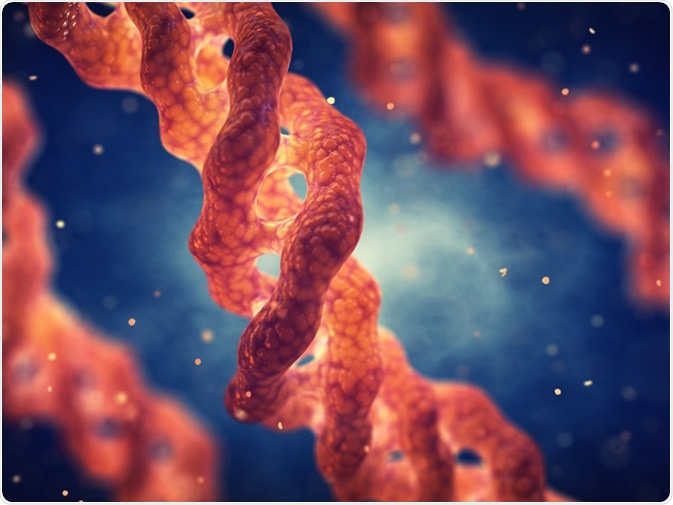Skip to:
Collagen is a major protein which is found in connective tissues and the extracellular matrix (ECM). Helical in structure, at least 27 types of collagen have been identified in the human body, with Types I-IV being the most prevalent. Comprising approximately 25 percent of all protein present throughout the body, more than all other forms of protein, it supports and strengthens all types of tissue, including teeth, tendons, bones, internal organs and skin. The function of collagen is to protect tissues from stretching and damage, acting as an intracellular “glue.”

Collagen triple helix molecule. Credit: nobeastsofierce / Shutterstock
Collagen Synthesis
One type of collagen is fibrillary collagen. Fibrillary collagen is synthesized in a complex process. mRNA is coded for by a set of 34 genes in the nucleus of the cell, which then undergo translation in the cytoplasm. This leads to the formation of pre-pro-peptide.
Pre-pro-peptide is then modified three times to form an alpha peptide. This step is followed by chemical modification, specifically glycosylation with glucose and galactose, of the propeptide lysines. Groups of three propeptides are then twisted to form a triple helical structure, producing procollagen.
The procollagen undergoes further modification in the Golgi apparatus by the addition of oligosaccharides and is secreted into the extracellular space. Loose ends of the procollagen are removed, forming tropocollagen. Ehlers-Danlos Syndrome, a hereditary condition, is produced by defects in this step.
The final step in the formation of fibrillary collagen involves covalent bonding between the molecules of tropocollagen. The enzyme which aids this step is lysyl oxidase, which produces aldehyde groups by acting on the hydroxylysines and lysines.
Factors Leading to Collagen Degradation
Factors which can lead to collagen degradation include ageing (this is the main cause), disease, exposure to UV radiation and smoking. A typical form of collagen degradation associated with smoking is the loss of collagen in the skin, leading to premature ageing of the epidermis (i.e. wrinkles). Researchers in Finland found that smoking affects collagen I and III synthesis.
Vitamin C deficiency can also negatively impact collagen production, a condition commonly known as scurvy. Vitamin C helps is required by the enzyme that connects lysine and proline residues during the procollagen synthesis step. Vitamin C is used up in this process as a cofactor by aiding hydroxylation of lysines and prolines. It must be noted that several vitamins and minerals act as catalysts for collagen production, but Vitamin C is one of the most important vitamins.
The main types of enzymes which are responsible for collagen degradation are collagenases, which belong to a group of enzymes called matrix metalloproteinases (MMPs.) Collagenases are released by several cells in the body including macrophages, fibroblasts, neutrophils and tumor cells. In chronic pressure ulcers, an influx of neutrophils releases MMP-8, a potent collagenase.
A common debilitating disease in humans associated with collagen degradation is osteoarthritis, which affects an estimated 27 million Americans, and most people over the age of 60 will suffer from this to some degree of severity. Osteogenesis imperfecta, an autosomal dominant type I collagen disorder, can range from mild to fatal. Another disorder which leads to collagen degradation is Ehlers-Danlos syndrome, an inherited collagen disorder with at least 6 different subtypes with various mutations of different collagen types.
Research into mechanisms which cause collagen degradation and the way the body produces collagen are therefore of interest to scientists and organisations in the fields of life sciences and medical study.
Studies on Collagen Degradation Pathways
The body can regulate how much collagen is present in connective tissue. This involves changes in how collagen is degraded. (G.J. Laurent, 1987.)
In a 2004 study, Pastley et al. found that collagen degradation could occur over time via host derived MMPs without the presence of any disease. The researchers demonstrated this with partially demineralized human teeth stored in artificial saliva with or without the addition of protease inhibitors or mineral oil. They observed that after 250 days the DCMs (demineralized collagen matrices) showed near total deterioration in the artificial saliva, but when they were incubated with mineral oil or protease inhibitors they were not. Therefore, the host body can break down collagen itself.
In a 1975 study by Berman it was found that tissue collagenases were inhibited by the human serum antiprotease alpha2-macroglobulin, metal-binding agents of the EDTA type, and by thiols. EDTA and Ca-EDTA was found to be more effective by 100 times than L-Cysteine and its derivatives on a molar basis. There appeared to be some efficacy in the treatment of corneal ulceration in humans. Though EDTA is irritant (and therefore should not be used as eye droplets) Ca-EDTA is a safe alternative. It was found that these compounds, cysteine and acetylcysteine held promise for treatment of corneal ulceration.
From these case studies, it can be surmised that the pathways for collagen degradation in the human body are complex and can be brought about by various factors including ageing, disease, vitamin deficiency, hereditary disorders and lifestyle choices. As collagen degradation can lead to numerous debilitating conditions, it is important that research into the pathways themselves and how these can be inhibited is given continued funding.
Further Reading
Last Updated: Oct 27, 2022